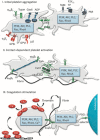Potentiation of thrombus instability: a contributory mechanism to the effectiveness of antithrombotic medications
- PMID: 29550950
- PMCID: PMC5889774
- DOI: 10.1007/s11239-018-1641-2
Potentiation of thrombus instability: a contributory mechanism to the effectiveness of antithrombotic medications
Abstract
The stability of an arterial thrombus, determined by its structure and ability to resist endogenous fibrinolysis, is a major determinant of the extent of infarction that results from coronary or cerebrovascular thrombosis. There is ample evidence from both laboratory and clinical studies to suggest that in addition to inhibiting platelet aggregation, antithrombotic medications have shear-dependent effects, potentiating thrombus fragility and/or enhancing endogenous fibrinolysis. Such shear-dependent effects, potentiating the fragility of the growing thrombus and/or enhancing endogenous thrombolytic activity, likely contribute to the clinical effectiveness of such medications. It is not clear how much these effects relate to the measured inhibition of platelet aggregation in response to specific agonists. These effects are observable only with techniques that subject the growing thrombus to arterial flow and shear conditions. The effects of antithrombotic medications on thrombus stability and ways of assessing this are reviewed herein, and it is proposed that thrombus stability could become a new target for pharmacological intervention.
Keywords: Antithrombotic drugs; Endogenous fibrinolysis; Platelet aggregation; Thrombosis; Thrombus dispersion.
Conflict of interest statement
Conflict of interest
The author reports no conflict of interest pertaining to this manuscript.
Research involving human and animal participants
This article does not contain any studies with human participants or animals.
Figures


Similar articles
-
Measuring Thrombus Stability at High Shear, Together With Thrombus Formation and Endogenous Fibrinolysis: First Experience Using the Global Thrombosis Test 3 (GTT-3).Clin Appl Thromb Hemost. 2023 Jan-Dec;29:10760296231181917. doi: 10.1177/10760296231181917. Clin Appl Thromb Hemost. 2023. PMID: 37551011 Free PMC article.
-
Thrombolytic and antithrombotic efficacy of the platelet GPIIb-IIIa antagonist DMP728.Coron Artery Dis. 1994 Nov;5(11):919-27. Coron Artery Dis. 1994. PMID: 7719524
-
Arterial Thrombus Stability: Does It Matter and Can We Detect It?J Am Coll Cardiol. 2017 Oct 17;70(16):2036-2047. doi: 10.1016/j.jacc.2017.08.065. J Am Coll Cardiol. 2017. PMID: 29025561 Review.
-
Antithrombotic properties of water-soluble carbon monoxide-releasing molecules.Arterioscler Thromb Vasc Biol. 2012 Sep;32(9):2149-57. doi: 10.1161/ATVBAHA.112.253989. Epub 2012 Jul 5. Arterioscler Thromb Vasc Biol. 2012. PMID: 22772756
-
Current perspectives in the treatment of thrombotic disorders.Semin Thromb Hemost. 1989 Apr;15(2):111-22. doi: 10.1055/s-2007-1002693. Semin Thromb Hemost. 1989. PMID: 2665082 Review.
Cited by
-
Maggot Kinase and Natural Thrombolytic Proteins.ACS Omega. 2024 May 2;9(20):21768-21779. doi: 10.1021/acsomega.4c01663. eCollection 2024 May 21. ACS Omega. 2024. PMID: 38799322 Free PMC article. Review.
References
-
- Yano Y, Ohmori T, Hoshide S, et al. Determinants of thrombin generation, fibrinolytic activity, and endothelial dysfunction in patients on dual antiplatelet therapy: involvement of factors other than platelet aggregability in Virchow’s triad. Eur Heart J. 2008;29:1729–1738. doi: 10.1093/eurheartj/ehn027. - DOI - PubMed
Publication types
MeSH terms
Substances
LinkOut - more resources
Full Text Sources
Other Literature Sources
Medical

